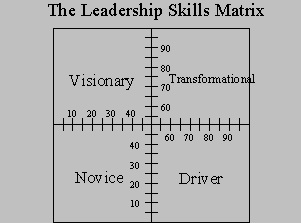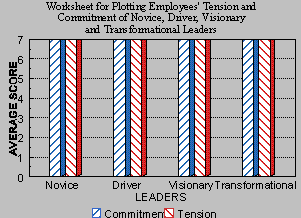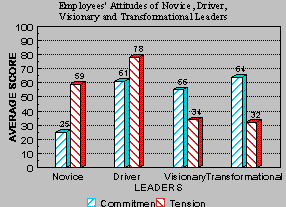
Frank Shipper, Ph.D. Professor of Management, Franklin P. Perdue School of Business Salisbury University Salisbury, MD 21801-6860 Phone: (410) 543-6333 FAX: (410) 548-2908 E-mail fmshipper@salisbury.edu INTERACTIVE EXERCISE: COMMITMENT, TENSION, AND LEADERSHIP SKILLS
This exercise can be used with any group of twenty or more participants. Fewer participants will probably not produce reliable results.
Steps:
1. Have the participants either (1) complete a self-scoring Survey of Leadership Practices (SLPHQ) on a boss that they have had or (2) use the results that they have received from their direct reports or associates (Both self-scoring and computer-scored surveys are available from The Clark Wilson Group 800-537-7249). If they use the self-scoring version they will have to plot their raw scores on the Your Leadership Practices plot to translate the raw scores into centile scores. If they have received a report back from others completing the computer scored version, they should use the centile scores from their direct reports to complete this exercise.
If the participants use the self-scoring Survey of Leadership Practices, they will also have to use the Tension and Commitment Scales at the end of this exercise as they are not part of that survey.
2. Ask the participants to follow the Scoring Instructions for the Leadership Skills Matrix.
3. Have the participants plot their scores on the Leadership Skills Matrix, and find their position on the matrix where the two points meet.
4. Ask the participants to form groups based on which quadrant they fell in on the Leadership Skills Matrix.
5. Ask the newly formed groups to compute and be ready to report the average for the tension and commitment scores for the group. Also, ask the members of the newly formed groups to develop a verbal description of the strengths and weaknesses of the individual profiled.
6. Plot the scores on an overhead made from the Worksheet for Plotting Subunit Tension and Commitment of Novice, Driver, Visionary, and Transformational Leaders, and discuss the results.
7. Show the results entitled, "Employees' Attitudes of Novice, Driver, Visionary, and Transformational Leaders," from a cross-organizational study where commitment, and tension data were also available.
SCORING INSTRUCTIONS FOR THE LEADERSHIP SKILLS MATRIX
A. Visionary Skills
To locate yourself (or someone else) on the vertical axis of the Leadership Skills Matrix record and average the centile scores of the following visionary skills:
| 1 | Vision/Imagination | |
| 2 | Risk-Taking/Venturesomeness | |
| 3 | Organizational Sensitivity | |
| 4 | Personal Awareness | |
| 5 | Persuasiveness | |
| 6 | Teaming | |
| 7 | Recognition | |
| Total | ||
| Average for Visionary Skills
(Total/7) |
B. Driving Skills
To locate yourself (or someone else) on the horizonal axis of the Leadership
Skills Matrix record and calculate the weighted average of the centile
scores of the following driving skills:
| 1. | Standards of Performance | X 1 | ||
| 2. | Perseverance | X 1 | ||
| 3. | Push/Pressure | X 2 | ||
| Total | ||||
| Weighted Average for
Driving Skills (Total/4) |
||||

GROUP WORKSHEET FOR AVERAGING
COMMITMENT & TENSION SCORES
Participants |
Individual
Commitment Scores |
Individual
Tension Scores |
| 1. | ||
| 2. | ||
| 3. | ||
| 4. | ||
| 5. | ||
| 6. | ||
| 7. | ||
| 8. | ||
| 9. | ||
| 10. | ||
| Total | ||
| X = Number of Participants X 6 | X= | |
| Y = Number of Participants X 5 | Y= | |
Group Average Commitment Score (Total Divided by X) |
||
| Group Average Tension Score
(Total Divided by Y) |


COMMITMENT
Please give a rating for the six statements below on how each one reflects your feelings about your job. Give your frank personal opinion.
You may think of the degree or extent to which each is true. Or if it is more appropriate, you may think of the frequency: 1, 2 = "Extremely low degree, seldom or never"; 3, 4, 5 = "An average degree, some of the time or about half"; 6, 7 = "A very high degree, all or almost all of the time."
Circle your rating for each question and then enter that rating in
the column at the right. When you have finished, add up the numbers and write the total at
the bottom of the column.
| A small degree, seldom or never |
Normal, average, sometimes, about half |
A high degree or almost always |
||||||
| 1. We work hard because we like it here ... | 1 | 2 | 3 | 4 | 5 | 6 | 7 | |
| 2. We try hard to do the work well ... | 1 | 2 | 3 | 4 | 5 | 6 | 7 | |
| 3. We put out a lot of effort to meet commitments ... | 1 | 2 | 3 | 4 | 5 | 6 | 7 | |
| 4. Most of the group are loyal to the organization ... | 1 | 2 | 3 | 4 | 5 | 6 | 7 | |
| 5. We are committed to reach our goals ... | 1 | 2 | 3 | 4 | 5 | 6 | 7 | |
| 6. We are dedicated to the organization ... | 1 | 2 | 3 | 4 | 5 | 6 | 7 | |
| TOTAL | ||||||||
Thank you.
TENSION
Please give a rating for the five statements below on how each one reflects your feelings about your job. Give your frank personal opinion.
You may think of the degree or extent to which each is true. Or if it is more appropriate, you may think of the frequency: 1, 2 = "Extremely low degree, seldom or never"; 3, 4, 5 = "An average degree, some of the time or about half"; 6, 7 = "A very high degree, all or almost all of the time."
Circle your rating for each question and then enter that rating in
the column at the right. When you have finished, add up the numbers and write the total at
the bottom of the column.
| A small degree, seldom or never |
Normal, average, sometimes, about half |
A high degree or almost always |
||||||
| 1. We feel a lot of stress in the work place ... | 1 | 2 | 3 | 4 | 5 | 6 | 7 | |
| 2. Things seem to be in a constant state of crisis ... | 1 | 2 | 3 | 4 | 5 | 6 | 7 | |
| 3. We feel uneasy in dealing with the leadership ... | 1 | 2 | 3 | 4 | 5 | 6 | 7 | |
| 4. There is conflict between the group and the leadership ... | 1 | 2 | 3 | 4 | 5 | 6 | 7 | |
| 5. The situation is full of tension ... | 1 | 2 | 3 | 4 | 5 | 6 | 7 | |
| TOTAL | ||||||||
Thank you.
REFERENCES
Jamal, Muhammad, (1985). "Job Stress and Job Performance: An Empirical Assessment," Organizational Behavior and Human Performance, February 1984, pp. 1-21.
Jamal, Muhammad, (1985). "Relationship of Job Stress to Job Performance," Human Relations, May 1985, pp. 409-24.
Shipper, Frank, (1995). "A Study of the Psychometric Properties of the Managerial Skill Scales of the Survey of Management Practices," Journal of Educational and Psychological Measurement, Vol. 55, No. 3, pp 486-497.
Shipper, Frank, (1994). "A Study of Managerial Skills of Women and Men and Their Impact on Employees' Attitudes and Career Success in a Nontraditional Organization." Abstract published in the Proceedings of the Academy of Management, Dallas, Texas, August 14-17, 1994, p. 471.
Shipper, Frank, (1991). "Mastery and Frequency of Managerial Behaviors Relative to Sub-unit Effectiveness," Human Relations, Vol. 44, No. 4, pp. 371-388.
Shipper, Frank. & Dillard, John E., Jr., (1994). "Comparing the Skills of Early Derailers vs. Fast Trackers, Late Derailers vs. Long-Term Fast Trackers, and Mid-career Derailers vs. "Recoverers." Abstract published in the Proceedings of the Academy of Management, Dallas, Texas, August 14-17, 1994, p. 424, (Winner of the Outstanding Paper on Management Development Award).
Shipper, Frank & Neck, Chris, (1990). "Subordinates' Observations: Feedback for Management Development," Human Resource Development Quarterly, Winter, pp. 371-385.
Shipper, Frank & White, Charles S. "Mastery, Frequency & Interaction of Managerial Behavior Relative to Subunit Effectiveness." Abstract to be published in the 1995 Proceedings of the Academy of Management, Vancouver, British Columbia, August 4-9, 1995.
Shipper, Frank & Wilson, Clark L., (1992). "The Impact of Managerial Behaviors on Group Performance, Stress and Commitment," published in Impact of Leadership, Kenneth E. Clark, Miriam B. Clark, and Donald P. Campbell, eds., Greensboro, NC: The Center for Creative Leadership, pp. 119-129.
Wilson, Clark L., (1980). "Identify Needs With Cost in Mind," Training and Development Journal, pp. 58-62.
Wilson, Clark L., O'Hare, Donal, & Shipper, Frank, (1990). "Task Cycle Theory: The Processes of Influence," In Measures of Leadership, Kenneth F. Clark and Miriam B. Clark, Editors. West Orange, New Jersey: Leadership Library of America, Inc.
Wilson, Clark L., & Wilson, Jane L., (1991). Teams and leaders: A manual for the Clark Wilson Publishing Company training and development programs. Silver Spring: The Clark Wilson Group.